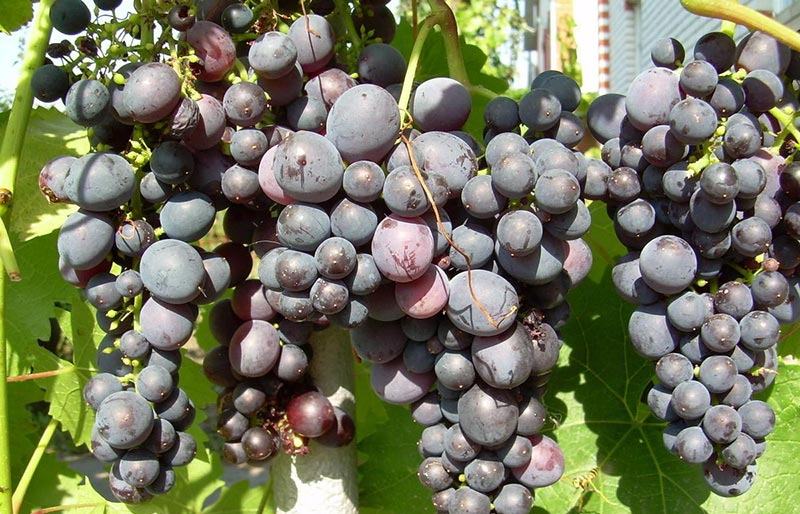 Grapes of the Muromets variety fully justify their name - this is a solid domestic variety with great endurance. Frost resistance of grapes, judging by the reviews, is even higher than in the official description. The berries do not differ in their original or refined taste, but they are sweet and large, and the yield is decent. The variety should be defined as reliable, trouble-free and high-quality.
Grapes of the Muromets variety fully justify their name - this is a solid domestic variety with great endurance. Frost resistance of grapes, judging by the reviews, is even higher than in the official description. The berries do not differ in their original or refined taste, but they are sweet and large, and the yield is decent. The variety should be defined as reliable, trouble-free and high-quality.
Content
Grade description
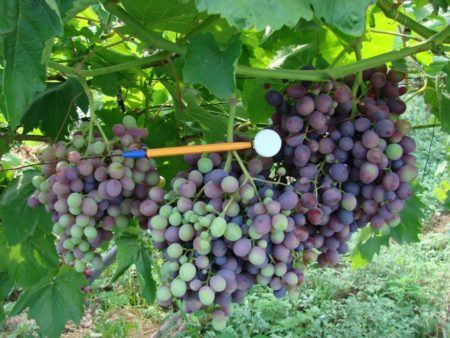
Muromets - grade blue grape, intended for cultivation in any regions of Russia where cultivation is possible. The variety is not a novelty; it was bred in 1962 and is still popular with gardeners. Most often, bushes of Muromets are found in areas in the northern regions. The parents of the variety were Severny and Pobeda, the crossing of which was carried out by I. Filipenko and Shtilin L.T., who worked at TsGL im. I.V. Michurina.
Structural features
As can be assumed from the name of the variety, the appearance of the bushes is monumental: Muromets is a vigorous grape with a thick trunk and branches, with powerful roots. The length of the shoots reaches 2-3 meters. The vines are covered with a not too thick edge of a cobweb type. The color of the roots is brown or brown-red.
The leaves on the vines are large and medium sized with an elongated central lobe and a serrated edge. A sheet plate in most cases has five blades, but can be three- or seven-bladed. The color of the leaf between the veins is light green, the vessels are pronounced, in shade lighter than the main part. In the lower part, the main veins can be painted in blue and red tones. The surface of the leaves is matte, sometimes wrinkles from the outside, acquiring a gray-green color. Petioles are brown-red.
The flowers are bisexual, pollination is of high quality. Bunches have a conical shape, differ in average density of filling with berries. They can be medium or large in size - the weight of the clusters ranges from 400 g to 1 kg.
Characteristics of berries
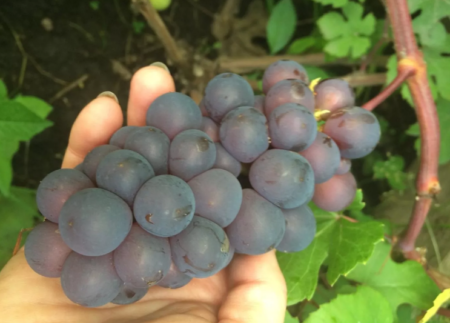
Muromets refers to varieties of early ripening (105-110 days from the beginning of the growing season). In the middle lane, the fruits on the main shoots are ready for harvest in early August, in the southern regions - in late July. Ripening berries on stepsons occurs a month later.
The fruits are large, with a diameter of about 20-23 mm, have a rounded, slightly elongated shape. The color of the berries is dark red or dark purple. The skin is thin, not noticeable when bitten, covered with a thin waxy coating. The fruits have an attractive appearance, which increases the commercial value of the crop.
The pulp is fleshy, crispy. A few seeds (2-4 pieces in each berry) are small in size. The amount of sugar in the fruit is 17-18%, the acid content is 7-8 g / l. To taste the berries are sweet with sourness, have a subtle aroma.
By appointment Muromets - dining room grade, the taste of berries is pleasant for fresh consumption, well suited for conservation. Fruit assessment on a ten-point tasting scale - 8.6 points.
Variety Productivity
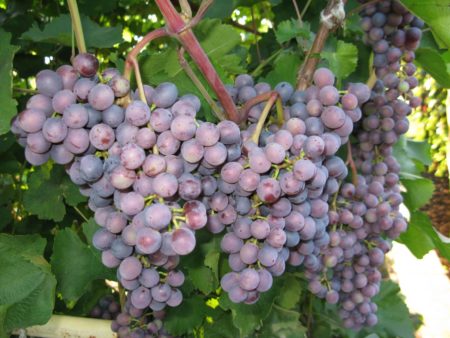
Muromets - high-yielding variety. 4-7 kg of fruits can be removed from one bush, 1.3-1.6 kg per 1 m2 of plantation. Berry weight - 4-5 g.
Most of the shoots that form on the bush are fruiting - from 7 to 9 for every ten vines. The optimal number of clusters that can ripen qualitatively is 1.1-1.5 pieces per shoot.
Sustainability indicators
Grade differs in complex stability:
- Muromets is practically not susceptible to fungal diseases, including mildew and oidium damage.
- Frost resistance - grapes are capable of withstanding a drop in temperature to -25 ... -27 ° C.
- Good resistance to drought.
- High adaptive qualities - the bush easily adapts to different growing conditions, young plants take root quickly after planting.
Muromets grapes show poor resistance to gray rot, can also be ill with chlorosis, bacterial cancer and bacteriosis. Of fungal diseases, it is vulnerable to anthracnosis and rubella.
Advantages and disadvantages of the variety
This variety is popular among gardeners with qualities such as:
- good yield with low demands;
- the ability to cultivate in the north due to the early ripening and frost resistance;
- non-susceptibility to defeat by powdery mildew, real and false;
- nutritional value of berries - pleasant taste, a small number of seeds;
- keeping crop, the possibility of transportation;
- attractive, marketable type of fruit - large, beautifully colored berries;
- high survival rate of planting material.
The disadvantages of the variety:
- susceptibility of grapes to bacterial and certain fungal diseases;
- the likelihood of fruit cracking after irrigation or rain, which was preceded by prolonged drought;
- cases of peeling berries without disturbances in care, which worsens the commercial quality of the bunches.
Features of agricultural technology varieties
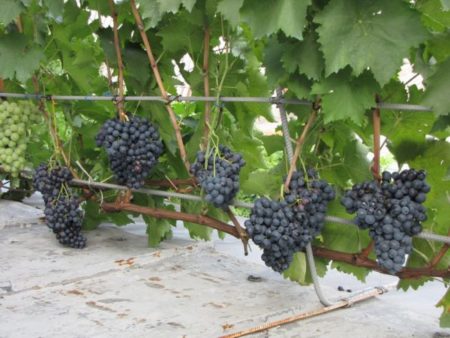
Grape care Muromets, basically, requires a standard, but approach to agricultural technology should be responsible. All activities should be carried out on a regular basis, without missing fertilizing or preventive spraying, pruning, normalizing and irrigating the bush during the season. In this case, there will be no problems with grapes.
Features of the care of the variety:
- Muromets cuttings easily take root and quickly develop in a new place. In the northern regions, for landing, you should prefer spring, in the south, with mild winters, landing spend even in winter - from October to March.
- Grapes are sensitive to soil acidity; they do not like either alkaline or acidic soils. The best option is neutral soils (pH 6-7).
- Going down in height, cuttings give out all the shoots. Subsequently, this quality will require careful attention to pruning. On the bush should be left no more than 40-45 vines. You need to choose shoots whose diameter is 6-12 cm.
- Trimming fruiting vines should be at the level of 9-10, maximum 12 eyes.
- It is recommended to carry out preventive treatment of bushes, primarily with drugs that prevent the development of gray rot.
- Grape vines in spring Muromets, as a rule, formed too many inflorescences. This should not be ignored - overload is critical for the variety. Normalization should begin at the flowering stage, before the formation of the ovary, leaving 2-3 inflorescences on each shoot.
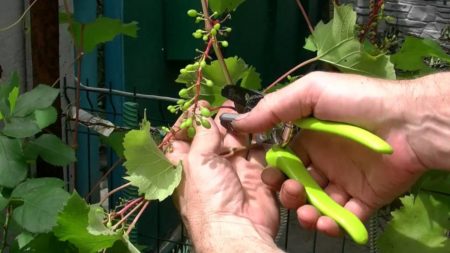
- The volume and number of clusters on the vines of Muromets do not correspond to the ability of the bushes to grow a quality crop. As a result, the berries lose in sweets, are smaller in size, overloaded vines often break. The second stage of normalization involves the removal of excess clusters.If the clusters are potentially large (600-1000 g in the maturity stage), it is worth leaving 1 per vine, if their total weight hardly exceeds 400-500 g, 2 can be left on one shoot.
- If part of the berries in the grape cluster is small (“peas”), it is optimal, albeit laborious, to pluck such fruits, otherwise by the time the remaining berries ripen, they will ripen and crack. It is impossible to send such a bunch for sale.
- It is advisable to cut the clusters immediately after ripening in order to remove the load from the shoots, although the crop can be stored on the bush for a long time.
- If the weather is rainy, you can only remove fruits intended for preservation or preserves. Harvest, which they plan to consume fresh or leave for raisins, must be harvested only on a dry day, otherwise the berries will lose their keeping quality and will most likely crack during transportation.
- The crop needs protective measures against wasps - nest destruction, spraying, traps in the form of containers with sweet water.
Gardeners reviews
Maria, 39 years old:
“Tasty grapes, and although the variety is not technical, it is quite possible to put a must on its basis. We tried, it turns out a good table wine. The pulp is quite juicy, pleases a small number of seeds. It was not possible to make dessert wine right away, for this, as it turned out, we needed to keep the clusters on the bush longer, until mid-autumn (for comparison, we remove the table wine at the end of September). But there is one minus - if you delay with the harvest, the risk of breaking the vine increases. "
Inna, 34 years old:
“Excellent harvest ripening, the first grape of the season in my area is always Muromets. There are a lot of fruitful vines, clusters on the stepsons of the first order, but already smaller in weight. Alas, grapes are subject to gray rot. Affected berries attract many wasps. ”
Peter, 46 years old:
“I had a couple of bushes of Muromets overwintering without shelter for several years in a row when the temperature reached -30 ° C. In the spring, it normally started growing, shoots and buds remained intact. But once he froze, and I can’t even say at what temperature the bushes “broke”, it was a very frosty winter, minus almost 40. But the bushes survived and fully recovered after a couple of years - shoots came out of sleeping buds. ”
Grade Muromets is suitable for cultivation for commercial purposes, although it should be considered as grapes "for yourself." Proper care in most cases ensures high commercial quality of the berries, but the likelihood of chopping individual fruits in clusters may disrupt sales plans.




 Non-covering winter-hardy grape varieties for Moscow region
Non-covering winter-hardy grape varieties for Moscow region How to keep the vine in winter
How to keep the vine in winter When can I transfer grapes to another place in the fall
When can I transfer grapes to another place in the fall How to cover and prepare grapes for the winter in the suburbs
How to cover and prepare grapes for the winter in the suburbs